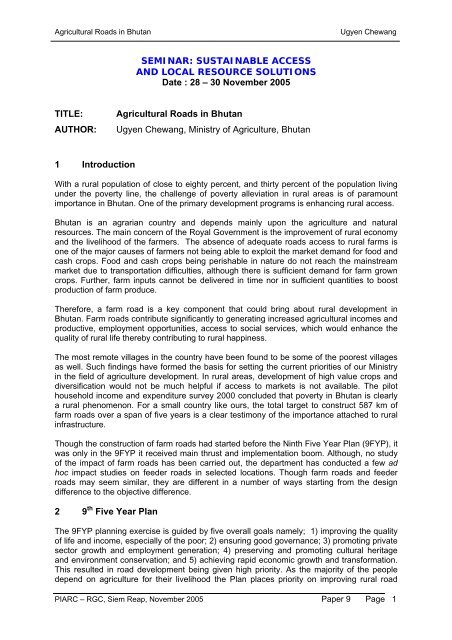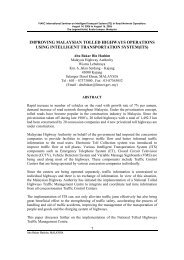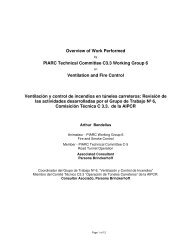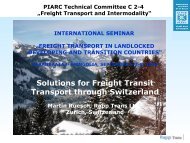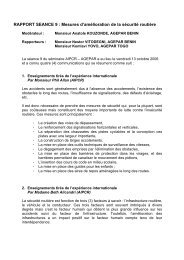Agricultural Roads in Bhutan AU
Agricultural Roads in Bhutan AU
Agricultural Roads in Bhutan AU
Create successful ePaper yourself
Turn your PDF publications into a flip-book with our unique Google optimized e-Paper software.
<strong>Agricultural</strong> <strong>Roads</strong> <strong>in</strong> <strong>Bhutan</strong><br />
Ugyen Chewang<br />
SEMINAR: SUSTAINABLE ACCESS<br />
AND LOCAL RESOURCE SOLUTIONS<br />
Date : 28 – 30 November 2005<br />
TITLE:<br />
<strong>AU</strong>THOR:<br />
<strong>Agricultural</strong> <strong>Roads</strong> <strong>in</strong> <strong>Bhutan</strong><br />
Ugyen Chewang, M<strong>in</strong>istry of Agriculture, <strong>Bhutan</strong><br />
1 Introduction<br />
With a rural population of close to eighty percent, and thirty percent of the population liv<strong>in</strong>g<br />
under the poverty l<strong>in</strong>e, the challenge of poverty alleviation <strong>in</strong> rural areas is of paramount<br />
importance <strong>in</strong> <strong>Bhutan</strong>. One of the primary development programs is enhanc<strong>in</strong>g rural access.<br />
<strong>Bhutan</strong> is an agrarian country and depends ma<strong>in</strong>ly upon the agriculture and natural<br />
resources. The ma<strong>in</strong> concern of the Royal Government is the improvement of rural economy<br />
and the livelihood of the farmers. The absence of adequate roads access to rural farms is<br />
one of the major causes of farmers not be<strong>in</strong>g able to exploit the market demand for food and<br />
cash crops. Food and cash crops be<strong>in</strong>g perishable <strong>in</strong> nature do not reach the ma<strong>in</strong>stream<br />
market due to transportation difficulties, although there is sufficient demand for farm grown<br />
crops. Further, farm <strong>in</strong>puts cannot be delivered <strong>in</strong> time nor <strong>in</strong> sufficient quantities to boost<br />
production of farm produce.<br />
Therefore, a farm road is a key component that could br<strong>in</strong>g about rural development <strong>in</strong><br />
<strong>Bhutan</strong>. Farm roads contribute significantly to generat<strong>in</strong>g <strong>in</strong>creased agricultural <strong>in</strong>comes and<br />
productive, employment opportunities, access to social services, which would enhance the<br />
quality of rural life thereby contribut<strong>in</strong>g to rural happ<strong>in</strong>ess.<br />
The most remote villages <strong>in</strong> the country have been found to be some of the poorest villages<br />
as well. Such f<strong>in</strong>d<strong>in</strong>gs have formed the basis for sett<strong>in</strong>g the current priorities of our M<strong>in</strong>istry<br />
<strong>in</strong> the field of agriculture development. In rural areas, development of high value crops and<br />
diversification would not be much helpful if access to markets is not available. The pilot<br />
household <strong>in</strong>come and expenditure survey 2000 concluded that poverty <strong>in</strong> <strong>Bhutan</strong> is clearly<br />
a rural phenomenon. For a small country like ours, the total target to construct 587 km of<br />
farm roads over a span of five years is a clear testimony of the importance attached to rural<br />
<strong>in</strong>frastructure.<br />
Though the construction of farm roads had started before the N<strong>in</strong>th Five Year Plan (9FYP), it<br />
was only <strong>in</strong> the 9FYP it received ma<strong>in</strong> thrust and implementation boom. Although, no study<br />
of the impact of farm roads has been carried out, the department has conducted a few ad<br />
hoc impact studies on feeder roads <strong>in</strong> selected locations. Though farm roads and feeder<br />
roads may seem similar, they are different <strong>in</strong> a number of ways start<strong>in</strong>g from the design<br />
difference to the objective difference.<br />
2 9 th Five Year Plan<br />
The 9FYP plann<strong>in</strong>g exercise is guided by five overall goals namely; 1) improv<strong>in</strong>g the quality<br />
of life and <strong>in</strong>come, especially of the poor; 2) ensur<strong>in</strong>g good governance; 3) promot<strong>in</strong>g private<br />
sector growth and employment generation; 4) preserv<strong>in</strong>g and promot<strong>in</strong>g cultural heritage<br />
and environment conservation; and 5) achiev<strong>in</strong>g rapid economic growth and transformation.<br />
This resulted <strong>in</strong> road development be<strong>in</strong>g given high priority. As the majority of the people<br />
depend on agriculture for their livelihood the Plan places priority on improv<strong>in</strong>g rural road<br />
PIARC – RGC, Siem Reap, November 2005 Paper 9 Page 1
<strong>Agricultural</strong> <strong>Roads</strong> <strong>in</strong> <strong>Bhutan</strong><br />
Ugyen Chewang<br />
<strong>in</strong>frastructure comb<strong>in</strong>ed with multi-sectoral plans for modernization of agriculture. These<br />
<strong>in</strong>terventions are aimed to enhance agricultural productivity as well as to improve access to<br />
markets. The observation that villagers nearer to the road are more prosperous <strong>in</strong> terms of<br />
economic and social well be<strong>in</strong>g than those further away is a clear <strong>in</strong>dication that poverty<br />
reduction, <strong>in</strong>creas<strong>in</strong>g opportunities and enhanc<strong>in</strong>g the quality of social services can be<br />
achieved by improv<strong>in</strong>g the rural access through <strong>in</strong>frastructure expansion.<br />
The <strong>Bhutan</strong>ese approach to development has been shaped and guided by the concept of<br />
Gross National Happ<strong>in</strong>ess (GNH) enunciated by His Majesty K<strong>in</strong>g Jigme S<strong>in</strong>gye Wangchuk<br />
<strong>in</strong> the late 1980s, which <strong>in</strong>dicates that development has many more dimensions and that<br />
development should be understood as a process that seeks to maximize happ<strong>in</strong>ess rather<br />
than economic growth.<br />
The Royal Government of <strong>Bhutan</strong> (RGoB) has addressed a wide range of poverty issues<br />
broadly through the expansion of social services, rural development and <strong>in</strong>come generation<br />
activities, where<strong>in</strong> a vast majority of our population has benefited <strong>in</strong> very tangible ways.<br />
3. Vision 2020<br />
In the Vision 2020 document, provisions have been <strong>in</strong>cluded that stress the importance of<br />
improv<strong>in</strong>g rural access through <strong>in</strong>frastructure expansion of roads.<br />
Local communities irrespective of their location with<strong>in</strong> the K<strong>in</strong>gdom stress the importance of<br />
roads and electricity. They serve to br<strong>in</strong>g the communities out of their isolation, they <strong>in</strong>crease<br />
access to markets and services, and they facilitate rural <strong>in</strong>dustrialization and hence create<br />
productive employment outside the RNR (Renewal Natural Resources) sector. Both roads<br />
and electricity are <strong>in</strong>strumental <strong>in</strong> improv<strong>in</strong>g both the standard of liv<strong>in</strong>g and quality of life <strong>in</strong><br />
the rural areas and are thus able to contribute to a reduction <strong>in</strong> rates of rural-urban<br />
migration.<br />
Farm<strong>in</strong>g and related activities must become more profitable and young people must perceive<br />
farm<strong>in</strong>g not as a subsistence activity they associate with ‘backwardness’ but as a field of<br />
opportunity. The cont<strong>in</strong>uation of the focus on rural development and the further<br />
commercialization of agriculture are essential components <strong>in</strong> our urbanization strategy.<br />
4. Farm Road: def<strong>in</strong>ition and mandate<br />
There are five categories of roads <strong>in</strong> <strong>Bhutan</strong>: highways, Dzongkhag roads, feeder roads,<br />
urban roads, and farm roads. A farm road is a road that l<strong>in</strong>ks agricultural production areas to<br />
the national highways and/or markets. Class D road type of the Road Design Manual<br />
(PWD/DoR), which is the lowest classification of motorable roads, is used as the geometric<br />
design standard of farm roads. Once a farm road is constructed and handed over to a<br />
community, the responsibility of repair and ma<strong>in</strong>tenance is placed on the community.<br />
The Royal Government has placed high priority to the construction of farm roads with the<br />
objective of l<strong>in</strong>k<strong>in</strong>g the potential agricultural surplus areas <strong>in</strong> the h<strong>in</strong>terland to markets or<br />
nearby highways to facilitate the movement of <strong>in</strong>puts, agricultural surplus products, farm<br />
mach<strong>in</strong>ery, etcetera. The aim of the Government is to improve the rural economy and<br />
ultimately to raise the overall liv<strong>in</strong>g standard <strong>in</strong> the rural villages and to make the rural areas<br />
more attractive <strong>in</strong> order to prevent rural-urban migration of these people.<br />
The exist<strong>in</strong>g Government policy mandates the Division of <strong>Roads</strong> (DoR) to construct roads.<br />
Under DoR, the pace of farm road construction has not picked up to the desired pace. This<br />
has also slowed down the pace of progress of RNR programs. Further, the farm roads have<br />
PIARC – RGC, Siem Reap, November 2005 Paper 9 Page 2
<strong>Agricultural</strong> <strong>Roads</strong> <strong>in</strong> <strong>Bhutan</strong><br />
Ugyen Chewang<br />
not been related to production and potential production areas. Thus, the Government has<br />
transferred the mandate of farm road construction to the M<strong>in</strong>istry of Agriculture (MoA).<br />
5. Eng<strong>in</strong>eer<strong>in</strong>g parameters<br />
The farm roads shall be most economical and environmental friendly if the follow<strong>in</strong>g<br />
eng<strong>in</strong>eer<strong>in</strong>g parameters are followed strictly:<br />
(a) The alignment should be as direct as possible to provide maximum economy <strong>in</strong> the<br />
construction, ma<strong>in</strong>tenance and transportation.<br />
(b) The selected route should be feasible <strong>in</strong> relation to atta<strong>in</strong><strong>in</strong>g grades below the maximum<br />
allowable gradient.<br />
(c) Unstable hilly features (rock dips, fissured strata, and landslide prone areas) that can<br />
cause considerable ma<strong>in</strong>tenance problems <strong>in</strong> the future should be avoided.<br />
(d) The vertical alignment should provide adequate sight distances over all crests. Needless<br />
rise and fall <strong>in</strong> the f<strong>in</strong>al road level should be avoided.<br />
(e) The follow<strong>in</strong>g specifications shall be adopted:<br />
Rul<strong>in</strong>g gradient 6% (1 <strong>in</strong> 16.7)<br />
Limit<strong>in</strong>g gradient 7% (1 <strong>in</strong> 14.3)<br />
Exceptional gradient 10% (1 <strong>in</strong> 10)<br />
Type of pavement<br />
-Road with ord<strong>in</strong>ary earth surface<br />
-Water-bound Macadam (WBM)<br />
B/R wall<br />
-Hammer dressed dry wall for 3m<br />
Formation width<br />
4.60 meters<br />
Carriageway width<br />
3.00 meters<br />
Shoulder<br />
0.50 meters (5% cross fall)<br />
Slide dra<strong>in</strong> width (V-shaped)<br />
0.60 meters<br />
Side slope<br />
1 <strong>in</strong> 2 <strong>in</strong> loose soil and 1 <strong>in</strong> 4 <strong>in</strong> stiff clay<br />
Design speed of road<br />
20 – 40 km per hour<br />
Pavement cross fall<br />
Radius of curvature<br />
4% <strong>in</strong> straight sections of road<br />
-M<strong>in</strong>imum – 25 meters<br />
-Exceptional – 10 meters<br />
(f) One pass<strong>in</strong>g place should be provided for every kilometer. These should be 20 meters<br />
long on <strong>in</strong>side edge and 10 meters long on the outside edge with 3 meters width.<br />
(g) Provision of suitable cross dra<strong>in</strong>age facilities where the farm roads cross a natural<br />
dra<strong>in</strong>age path. For smaller catchments, the cross dra<strong>in</strong>age structure should <strong>in</strong>variably be<br />
a culvert arrangement, whereas for larger catchments the cross dra<strong>in</strong>age structure<br />
should be a multi-cell culvert or a wooden bridge.<br />
6 Implementation responsibilities<br />
The RNR eng<strong>in</strong>eer<strong>in</strong>g Division of the Department of Agriculture is assigned as the lead<br />
agency <strong>in</strong> the plann<strong>in</strong>g of the farm road development program at the national level. As<br />
outl<strong>in</strong>ed <strong>in</strong> the M<strong>in</strong>istry’s ‘Guidel<strong>in</strong>es for Farm <strong>Roads</strong> Development’ the implementation<br />
arrangement is specified below.<br />
The concept of relat<strong>in</strong>g farm roads to production and potential production areas should not<br />
be compromised <strong>in</strong> the implementation. The Dzongkhag will be the implement<strong>in</strong>g agency for<br />
the farm road construction.<br />
The role of agencies at central and Dzongkhag level are specified below.<br />
The M<strong>in</strong>istry of Agriculture is responsible for:<br />
PIARC – RGC, Siem Reap, November 2005 Paper 9 Page 3
<strong>Agricultural</strong> <strong>Roads</strong> <strong>in</strong> <strong>Bhutan</strong><br />
Ugyen Chewang<br />
• national plann<strong>in</strong>g and programm<strong>in</strong>g for Farm <strong>Roads</strong> development;<br />
• ensur<strong>in</strong>g that all cooperat<strong>in</strong>g agencies fulfill their implementation roles <strong>in</strong> accordance<br />
with the Guidel<strong>in</strong>es;<br />
• work<strong>in</strong>g closely with the M<strong>in</strong>istry of Works and Human Settlement <strong>in</strong> plann<strong>in</strong>g the<br />
road network of the country;<br />
• proper coord<strong>in</strong>ation to ensure optimum utilization of limited resources;<br />
• seek<strong>in</strong>g adequate resources to support the selected roads;<br />
• sign<strong>in</strong>g a Memorandum of Understand<strong>in</strong>g (MoU) with the Dzongkhags.<br />
The Eng<strong>in</strong>eer<strong>in</strong>g Division (ED) of the Department of Agriculture will:<br />
• lead the technical plann<strong>in</strong>g of farm roads development;<br />
• screen out road proposals received from Dzongkhags us<strong>in</strong>g the selection criteria;<br />
• co-ord<strong>in</strong>ate with Forestry Development Corporation Limited (FDCL) to plan road<br />
construction <strong>in</strong> areas that fall with<strong>in</strong> their Forestry Management Units;<br />
• support Dzongkhags <strong>in</strong> selection, survey, design and construction plann<strong>in</strong>g and<br />
provide timely technical back-stopp<strong>in</strong>g;<br />
• along with other relevant agencies carry out monitor<strong>in</strong>g and evaluation of the<br />
programme;<br />
• where feasible, provide construction mach<strong>in</strong>ery on hire from its centralized pool.<br />
(Although the contractors are expected to arrange their own mach<strong>in</strong>ery, the M<strong>in</strong>istry<br />
will ma<strong>in</strong>ta<strong>in</strong> its mach<strong>in</strong>ery base to ensure that construction mach<strong>in</strong>ery are available<br />
at all times to avoid delays.)<br />
The Dzongkhag is responsible for:<br />
• putt<strong>in</strong>g up proposals submitted by GYTs to the DYT. The DYT shall screen and<br />
prioritize the Dzongkhag’s programme;<br />
• the day-to-day implementation of the programme;<br />
• obta<strong>in</strong><strong>in</strong>g all necessary clearance certificates and complete other pre-construction<br />
requirements like survey, design, and estimat<strong>in</strong>g;<br />
• contract<strong>in</strong>g out the road construction follow<strong>in</strong>g standard procedures;<br />
• manag<strong>in</strong>g and supervis<strong>in</strong>g the construction <strong>in</strong> conformity with exist<strong>in</strong>g Guidel<strong>in</strong>es to<br />
ensure adequate quality standards and timely completion;<br />
• send<strong>in</strong>g regular progress reports to enable the ED to monitor progress;<br />
• sign<strong>in</strong>g a MoU with the beneficiaries upon completion of construction.<br />
The beneficiaries will:<br />
• submit their proposal to GYT. The GYT shall assess the need and <strong>in</strong>corporate <strong>in</strong> their<br />
plans;<br />
• assist the Dzongkhag <strong>in</strong> the detail <strong>in</strong>vestigations lead<strong>in</strong>g to f<strong>in</strong>al selection;<br />
• appo<strong>in</strong>t representative(s) who along with the Dzongkhag eng<strong>in</strong>eers will be<br />
responsible for supervision and quality control dur<strong>in</strong>g construction;<br />
• sign a MoU with the Dzongkhag to form an association/cooperative for operation and<br />
ma<strong>in</strong>tenance of the road.<br />
7 Site selection process<br />
As outl<strong>in</strong>ed <strong>in</strong> the ‘Guidel<strong>in</strong>es for Farm Road Development’, the farmers shall put a request<br />
to GYT and discuss the genu<strong>in</strong>e need for such a proposal. If the GYT resolves that the need<br />
was genu<strong>in</strong>e then the GYT Chairman shall certify the parameters, except the viability<br />
analysis and eng<strong>in</strong>eer<strong>in</strong>g parameters, and submit the same to Dzongkhag. The RNR Sector<br />
Heads and Dzongkhag eng<strong>in</strong>eers shall visit the proposed sites and reconfirm the submission<br />
by GYT, and accord<strong>in</strong>gly submit to the DYT session. If the DYT resolution is to go ahead as<br />
requested, a central team from MoA shall visit the site and verify if the parameters are met.<br />
PIARC – RGC, Siem Reap, November 2005 Paper 9 Page 4
<strong>Agricultural</strong> <strong>Roads</strong> <strong>in</strong> <strong>Bhutan</strong><br />
Ugyen Chewang<br />
Technical sanction shall be accorded after the technical, social and economic appraisals. In<br />
the event if there are too many viable proposals from different Dzongkhags priority for<br />
implementation shall be given to those potential areas with fewer roads. As far as possible,<br />
equity <strong>in</strong> the development of farm roads shall be ensured.<br />
The construction shall generally follow the technical specifications laid down <strong>in</strong> the<br />
‘Guidel<strong>in</strong>es for Farm Road Development’ of the M<strong>in</strong>istry of Agriculture. Farmers benefit<strong>in</strong>g<br />
from the farm road shall agree to form themselves <strong>in</strong>to Group/Association to implement and<br />
ma<strong>in</strong>ta<strong>in</strong> the road.<br />
Active participation of the farmers shall be given importance. They shall be <strong>in</strong>volved right<br />
from the beg<strong>in</strong>n<strong>in</strong>g i.e. from the choice of alignment of road, plann<strong>in</strong>g, design<strong>in</strong>g and through<br />
construction phase. This is deemed important with the idea that these exercises will enhance<br />
their skills <strong>in</strong> rout<strong>in</strong>e operation and ma<strong>in</strong>tenance and <strong>in</strong> <strong>in</strong>still<strong>in</strong>g a sense of ownership.<br />
Achiev<strong>in</strong>g this calls for support to farmers to: establish associations/committees, draft<br />
constitution and bylaws for implement<strong>in</strong>g and ma<strong>in</strong>ta<strong>in</strong><strong>in</strong>g its activities, open and operate<br />
bank accounts for future ma<strong>in</strong>tenance, and enhance their technical and managerial<br />
capability. Once completed and handed over, the beneficiary committees should be <strong>in</strong><br />
position to take up the responsibility of operation and ma<strong>in</strong>tenance.<br />
8 Farm road selection parameters<br />
8.1 Market outlet<br />
Farm roads should either connect production areas directly to markets or feed to other road<br />
types. An isolated farm road, not bridg<strong>in</strong>g the production areas to markets and other outlets,<br />
shall defeat the objective of the farm roads.<br />
8.2 Road length<br />
The farm road proposed shall benefit a certa<strong>in</strong> sphere of production areas. This area shall<br />
be identified and demarcated either <strong>in</strong> adm<strong>in</strong>istrative units or <strong>in</strong> beneficiary groups. The size<br />
of the area and number of beneficiaries associated with it shall be important factors<br />
determ<strong>in</strong><strong>in</strong>g the length of the road.<br />
Farm roads cannot meet the entire requirement of rural access for the <strong>Bhutan</strong>ese farmers.<br />
They are not meant to be a substitute for the Feeder Road Programme of DOR. Thus,<br />
lengthy roads requir<strong>in</strong>g several years of construction should be avoided. For practical<br />
purposes, road lengths of over ten kilometres per site will not be selected. And every<br />
kilometre of the road should be able to serve an average of ten households.<br />
8.3 Cross-dra<strong>in</strong>age structures<br />
The M<strong>in</strong>istry of Agriculture cannot support roads requir<strong>in</strong>g the construction of permanent<br />
bridges. Bridges are complex and expensive structures and cannot be covered under the<br />
scope of Farm <strong>Roads</strong>. Cross-dra<strong>in</strong>age structures will <strong>in</strong>clude culverts, causeways and light<br />
wooden bridges. If the road has to cross a large river, the Dzongkhag will make separate<br />
arrangements for the bridge.<br />
8.4 Technology adoption<br />
After the road has been built, farmers will be required to implement specific projects to<br />
demonstrate the benefits of easy access to markets and other services. They will adopt<br />
some improved technologies promoted by the RNR sector suited to the production potential<br />
of the area. Local resource endowments and climatic conditions will <strong>in</strong>fluence the choice.<br />
The project will focus on any of the follow<strong>in</strong>g: improved agronomic practices, HYV of cereals,<br />
pasture development, social forestry, AI and improved livestock breeds, formation of<br />
farmers’ cooperatives, etcetera.<br />
PIARC – RGC, Siem Reap, November 2005 Paper 9 Page 5
<strong>Agricultural</strong> <strong>Roads</strong> <strong>in</strong> <strong>Bhutan</strong><br />
Ugyen Chewang<br />
8.5 Environment factors<br />
No road sites shall disturb declared reserves, and catchment areas. No other activities<br />
considered harmful to the environment, such as, quarry<strong>in</strong>g, and logg<strong>in</strong>g should operate on<br />
the farm roads or their vic<strong>in</strong>ity. The excavated soil and other materials shall not be dumped<br />
over the edge of the road but properly disposed <strong>in</strong> selected locations.<br />
8.6 Timeframe<br />
The length of the road and the geo-physical conditions <strong>in</strong> the area will determ<strong>in</strong>e the time<br />
required to complete construction. The Dzongkhag Eng<strong>in</strong>eer<strong>in</strong>g Section (DES) <strong>in</strong><br />
consultation with the Eng<strong>in</strong>eer<strong>in</strong>g Division shall, depend<strong>in</strong>g on the topography and other<br />
physical features of the site, estimate the time required for construction.<br />
The farm road after completion of construction requires some time for proper stabilization. It<br />
will depend mostly on the length of the road and eng<strong>in</strong>eer<strong>in</strong>g parameters. An establishment<br />
period of one year after satisfactory completion will be considered the defect liability period<br />
dur<strong>in</strong>g which the contractor’s security deposit will be used for repair of damages unless<br />
caused by natural disasters. The road will then be formally handed over to the beneficiary<br />
group.<br />
8.7 Equity development<br />
The balanced development pr<strong>in</strong>ciples shall be promoted, where applicable. While the equity<br />
development of farm roads may contradict the purpose of bridg<strong>in</strong>g market and production<br />
and potential production areas by roads, there shall be cases where the implementation may<br />
require prioritization because of resource constra<strong>in</strong>ts with the Government. In such cases,<br />
priority shall be given to those potential areas with fewer roads if all other criteria are met.<br />
The Eng<strong>in</strong>eer<strong>in</strong>g Division will ensure equity development of farm roads.<br />
9 Mechanization<br />
Until recently, the construction of the farm roads was done on cost shar<strong>in</strong>g basis between<br />
the RGoB and the beneficiaries. The labour component had to be born by the benefit<strong>in</strong>g<br />
communities. However, consider<strong>in</strong>g the number of programmes implemented with<br />
beneficiary contribution, difficulty was experienced to make substantial progress. Given the<br />
huge numbers of farm roads construction planned, it was seen as the best option to contract<br />
the construction works to the private sector. The construction will be managed by the<br />
Dzongkhag and the beneficiaries. With the <strong>in</strong>volvement of the private sector, considerable<br />
progress has been achieved. Most of the road contractors are equipped with huge<br />
mach<strong>in</strong>ery required for the road work which is not only faster than labour but also cheaper.<br />
The most commonly used mach<strong>in</strong>ery used <strong>in</strong> the farm roads construction are listed below.<br />
Bulldozer<br />
Heavy earth mov<strong>in</strong>g mach<strong>in</strong>ery like bulldozers are efficient <strong>in</strong> formation cutt<strong>in</strong>g and sub<br />
grade preparation however are preferred to other mach<strong>in</strong>es which can also be used <strong>in</strong><br />
different ways. This is also <strong>in</strong> l<strong>in</strong>e with us<strong>in</strong>g mach<strong>in</strong>ery, which can construct roads <strong>in</strong> a more<br />
environmentally friendly manner.<br />
Excavator<br />
Bulldozers are fast be<strong>in</strong>g replaced by excavators due to their advantage over the former. It<br />
can excavate, load and dispose excavated materials <strong>in</strong> a much better location. Back slope<br />
cutt<strong>in</strong>g can be achieved successfully with this mach<strong>in</strong>ery. Ow<strong>in</strong>g to its multiple uses, this<br />
mach<strong>in</strong>ery is fast becom<strong>in</strong>g popular <strong>in</strong> the road construction <strong>in</strong>dustry.<br />
PIARC – RGC, Siem Reap, November 2005 Paper 9 Page 6
<strong>Agricultural</strong> <strong>Roads</strong> <strong>in</strong> <strong>Bhutan</strong><br />
Ugyen Chewang<br />
Dump truck<br />
Dump trucks are trucks which can carry about 10 ton. It is used for dispos<strong>in</strong>g excavated soil<br />
<strong>in</strong> an environmentally friendly manner. The debris are loaded by excavator and unload<strong>in</strong>g<br />
can be done by itself.<br />
Air compressor<br />
Dur<strong>in</strong>g the construction, heavy rocks are blasted. For blast<strong>in</strong>g, holes need to be drilled us<strong>in</strong>g<br />
an air compressor.<br />
Wheel-loader<br />
Wheel-loaders are primarily used to load excavated material to the dump trucks. However<br />
this mach<strong>in</strong>ery can also be used to excavate and push debris.<br />
10 Road ma<strong>in</strong>tenance<br />
Unlike other categories of road, no annual ma<strong>in</strong>tenance budget is ma<strong>in</strong>ta<strong>in</strong>ed. On<br />
completion of the construction works, the beneficiaries will sign a MoU with the Dzongkhag<br />
for operation and ma<strong>in</strong>tenance of the road. Dzongkhag will conduct regular visit to assess<br />
how the ma<strong>in</strong>tenance is carried out and advise accord<strong>in</strong>gly.<br />
In the event of major problems, the concerned Dzongkhag will carry out assessment of the<br />
damages and after establish<strong>in</strong>g that these damages were not caused by negligence on the<br />
part of the beneficiaries, the Dzonkhag will then arrange for repair works follow<strong>in</strong>g standard<br />
norms.<br />
Farmers benefit<strong>in</strong>g from the farm road shall agree to form a group or a cooperative to<br />
implement and ma<strong>in</strong>ta<strong>in</strong> the road. The group/cooperative shall have its own constitution and<br />
bylaws for implement<strong>in</strong>g its activities. Farmers have local arrangement for ma<strong>in</strong>tenance of<br />
Chhu-lam and Tsa-lam, where a road is equally divided <strong>in</strong>to several sections, and each<br />
section is handed over to a group of farmers. Similar mechanism may be adopted and<br />
applied for the road ma<strong>in</strong>tenance.<br />
11 <strong>Roads</strong> are not enough<br />
Provision of a road alone will not be of much use if it is not used effectively. <strong>Roads</strong> alone do<br />
not guarantee to improve the livelihood and reduce poverty if adequate transport facilities<br />
are not there. Vehicles will be few on these roads as passengers and loads are few and<br />
have high probability of gett<strong>in</strong>g stuck dur<strong>in</strong>g wet period. Therefore alternative transportation<br />
means, which are most effective and affordable to the farmers, need to be explored.<br />
M<strong>in</strong>istry of Agriculture under the leadership of Lyonpo Sangye Ngyedup has started<br />
redesign<strong>in</strong>g the RNR centres to service the Geogs <strong>in</strong> multiple ways. The centre will be the<br />
hub of geog where the development activities of the Geogs will be centered. Apart from<br />
office of agriculture services, other offices and social services will be also concentrated<br />
with<strong>in</strong> the centre such that people com<strong>in</strong>g for one reason can use the benefit of other<br />
services as well. One of the units that will be housed is a power tiller hire and ma<strong>in</strong>tenance<br />
workshop. With rural connectivity, more and more farmers are procur<strong>in</strong>g power tillers, which<br />
is the <strong>in</strong>dication of improvement of livelihood. For those farmers who could not afford it, they<br />
can hire it from the geog centre. This is a s<strong>in</strong>cere effort to help the poorer farmers. A power<br />
tiller is perhaps the most suited mach<strong>in</strong>ery to the <strong>Bhutan</strong>ese farmers consider<strong>in</strong>g the fact<br />
that it can plough and could also be used for transportation of goods to the markets. This<br />
also allows mechanization of the farms and takes care of the labour shortages <strong>in</strong> the farm.<br />
PIARC – RGC, Siem Reap, November 2005 Paper 9 Page 7
<strong>Agricultural</strong> <strong>Roads</strong> <strong>in</strong> <strong>Bhutan</strong><br />
Ugyen Chewang<br />
12 Conclusions<br />
Farm roads penetrate <strong>in</strong>to the heart of rural community and reach those needy poor for<br />
whom road access will <strong>in</strong>crease their <strong>in</strong>come and reduce poverty. The perishable products<br />
like vegetables and dairy products cannot reach market centres where the demand is high<br />
due to lack of speedy and quick means of transport. The villagers have to dispose it off <strong>in</strong> the<br />
village itself where the prices are quite low. Therefore farm roads which reduce travel time<br />
and improve access to the facilities and services are highly needed.<br />
Visits to the different villages confirm that communities near the road are much better off<br />
than the villages further away from the road. It is evident that remoteness does contribute to<br />
the poverty and that road access will be a key factor <strong>in</strong> alleviat<strong>in</strong>g poverty. The result of the<br />
impact study of the rural roads <strong>in</strong> selected areas done by M<strong>in</strong>istry of F<strong>in</strong>ance clearly shows<br />
the positive effect of roads <strong>in</strong> <strong>in</strong>creas<strong>in</strong>g the liv<strong>in</strong>g condition and reduc<strong>in</strong>g the poverty.<br />
Thus, it can be clearly said that a road br<strong>in</strong>gs about tremendous socio-economic<br />
development <strong>in</strong> the village and <strong>in</strong>creases the quality of life and the happ<strong>in</strong>ess of the people,<br />
especially when comb<strong>in</strong>ed with other <strong>in</strong>terventions like the development of multi-functional<br />
RNR centres.<br />
PIARC – RGC, Siem Reap, November 2005 Paper 9 Page 8
<strong>Agricultural</strong> <strong>Roads</strong> <strong>in</strong> <strong>Bhutan</strong><br />
Ugyen Chewang<br />
List of Acronyms<br />
DYT Dzongkhag Yargye Tshodgue<br />
GYT Geog Yargye Tshogchung<br />
DES District Eng<strong>in</strong>eer<strong>in</strong>g Cell<br />
GNH Gross National Happ<strong>in</strong>ess<br />
ED<br />
Eng<strong>in</strong>eer<strong>in</strong>g Division<br />
PWD Public Works Department<br />
DoR Department of <strong>Roads</strong><br />
DoA Department of Agriculture<br />
MoA M<strong>in</strong>istry of Agriculture<br />
MoU Memorandum of Understand<strong>in</strong>g<br />
RNR Renewal Natural Resources<br />
RGoB Royal Government of <strong>Bhutan</strong><br />
9FYP 9 th Five Year Plan<br />
Glossary<br />
Dzongkhag<br />
Geog<br />
DYT<br />
GYT<br />
District<br />
Sub-district or Block<br />
District Development Committee<br />
Block Development Committee<br />
References<br />
National Environment Commission (1998), The Middle Path: National Environment Strategy<br />
for <strong>Bhutan</strong>, Royal Government of <strong>Bhutan</strong>, Thimphu.<br />
Plann<strong>in</strong>g Commission (1999), <strong>Bhutan</strong> 2020: A Vision for Peace, Prosperity and Happ<strong>in</strong>ess,<br />
Royal Government of <strong>Bhutan</strong>, Thimphu.<br />
M<strong>in</strong>istry of Agriculture (2005), Rural-Urban Migration <strong>in</strong> <strong>Bhutan</strong>, Policy and plann<strong>in</strong>g Division,<br />
M<strong>in</strong>istry of Agriculture, Royal Government of <strong>Bhutan</strong>, Thimphu.<br />
M<strong>in</strong>istry of F<strong>in</strong>ance, Pilot Participatory Impact Assessment of Rural <strong>Roads</strong> on Rural Poverty,<br />
Department of Plann<strong>in</strong>g, Royal Government of <strong>Bhutan</strong>, Thimphu.<br />
M<strong>in</strong>istry of F<strong>in</strong>ance (2004), Poverty Reduction Strategy Paper, Department of Plann<strong>in</strong>g,<br />
Royal Government of <strong>Bhutan</strong>, Thimphu.<br />
M<strong>in</strong>istry of F<strong>in</strong>ance (2002), N<strong>in</strong>th Plan Document, Department of Plann<strong>in</strong>g, Royal<br />
Government of <strong>Bhutan</strong>, Thimphu.<br />
M<strong>in</strong>istry of Agriculture (2003), Guidel<strong>in</strong>es for Farm Road Development, Royal Government of<br />
<strong>Bhutan</strong>.<br />
PIARC – RGC, Siem Reap, November 2005 Paper 9 Page 9


